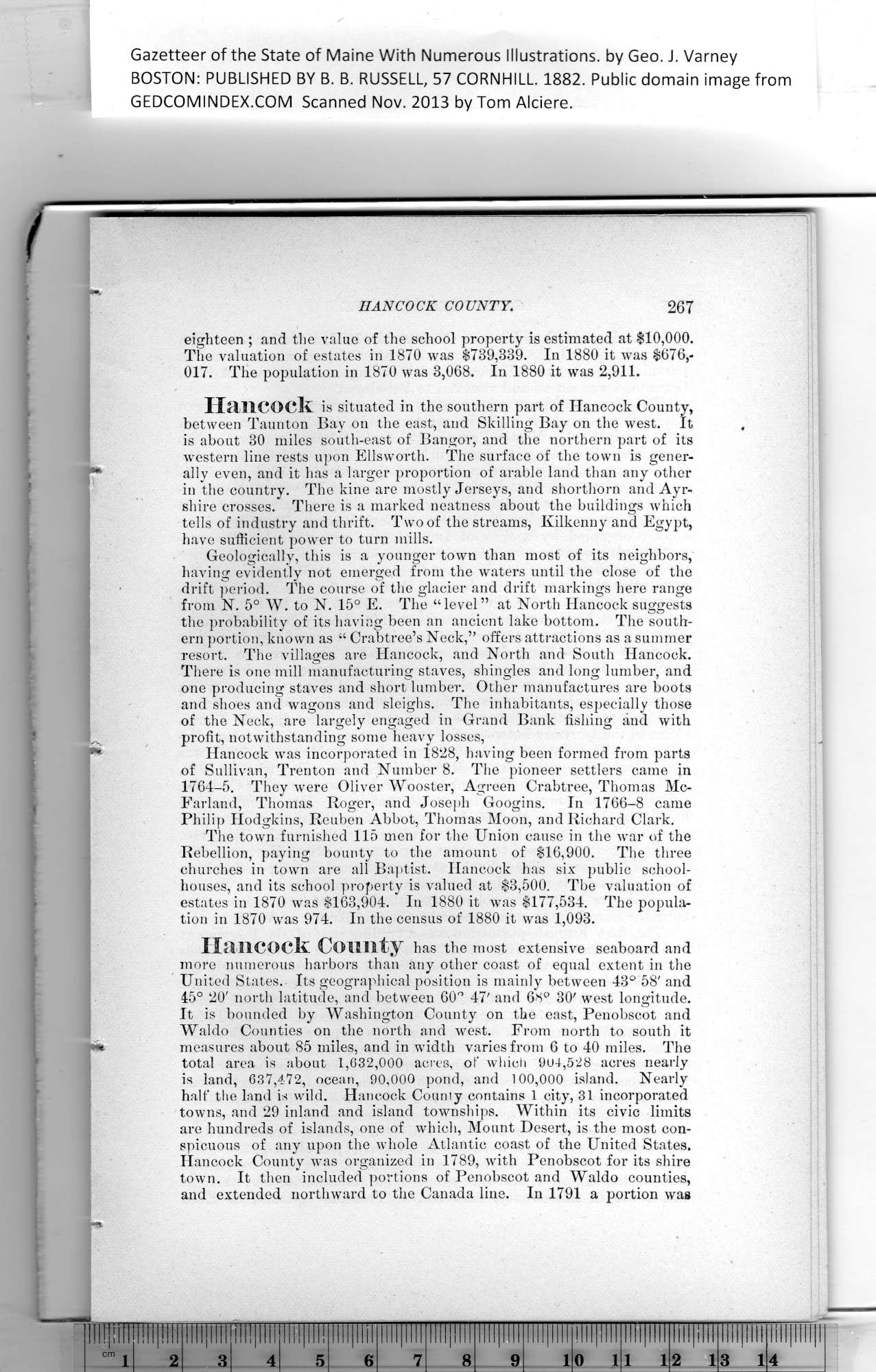|
Gazetteer of the State of Maine With Numerous Illustrations, by Geo. J. Varney
BOSTON: PUBLISHED BY B. B. RUSSELL, 57 CORNHILL. 1882. Public domain image from
HANCOCK COUNTY.
eighteen ; and the value of the school property is estimated at $10,000.
The valuation of estates in 1870 was $739,389. In 1880 it was $676,-
017. The population in 1870 was 3,068. In 1880 it was 2,911.
Hancock is situated in the southern part of Hancock County,
between Taunton Bay on the east, and Skilling Bay on the west. It
is about 30 miles south-east of Bangor, and the northern part of its
western line rests upon Ellsworth. The surface of the town is gener-
ally even, and it has a larger proportion of arable land than any other
in the country. The kine are mostly Jerseys, and shorthorn and Ayr-
shire crosses. There is a marked neatness about the buildings which
tells of industry and thrift. Two of the streams, Kilkenny and Egypt,
have sufficient power to turn mills.
Geologically, this is a younger town than most of its neighbors,
having evidently not emerged from the waters until the close of the
drift period. The course of the glacier and drift markings here range
from N. 5° W. to N. 15° E. The “level” at North Hancock suggests
the probability of its having been an ancient lake bottom. The south-
ern portion, known as “ Crabtree’s Neck,” offers attractions as a summer
resort. The villages are Hancock, and North and South Hancock.
There is one mill manufacturing staves, shingles and long lumber, and
one producing staves and short lumber. Other manufactures are boots
and shoes and wagons and sleighs. The inhabitants, especially those
of the Neck, are largely engaged in Grand Bank fishing and with
profit, notwithstanding some heavy losses,
Hancock was incorporated in 1828, having been formed from parts
of Sullivan, Trenton and Number 8. The pioneer settlers came in
1764-5. They were Oliver Wooster, Agreen Crabtree, Thomas Mc-
Farland, Thomas Roger, and Joseph Googins. In 1766-8 came
Philip Hodgkins, Reuben Abbot, Thomas Moon, and Richard Clark.
The town furnished 115 men for the Union cause in the war of the
Rebellion, paying bounty to the amount of $16,900. The three
churches in town are all Baptist. Hancock has six public school-
houses, and its school property is valued at $3,500. Tbe valuation of
estates in 1870 was $163,904. In 1880 it was $177,534. The popula-
tion in 1870 was 974. In the census of 1880 it was 1,093.
Hancock County has the most extensive seaboard and
more numerous harbors than any other coast of equal extent in the
United States. Its geographical position is mainly between 43° 58' and
45° 20' north latitude, and between 60° 47' and 68° 30' west longitude.
It is bounded by Washington County on the east, Penobscot and
Waldo Counties on the north and west. From north to south it
measures about 85 miles, and in width varies from 6 to 40 miles. The
total area is about 1,632,000 acres, of which 904,528 acres nearly
is land, 637,472, ocean, 90,000 pond, and 100,000 island. Nearly
half the land is wild. Hancock County contains 1 city, 31 incorporated
towns, and 29 inland and island townships. Within its civic limits
are hundreds of islands, one of which, Mount Desert, is the most con-
spicuous of any upon the whole Atlantic coast of the United States.
Hancock County was organized in 1789, with Penobscot for its shire
town. It then included portions of Penobscot and Waldo counties,
and extended northward to the Canada line. In 1791 a portion was
PREVIOUS PAGE ... NEXT PAGE
This page was written in HTML using a program written in Python 3.2
|
